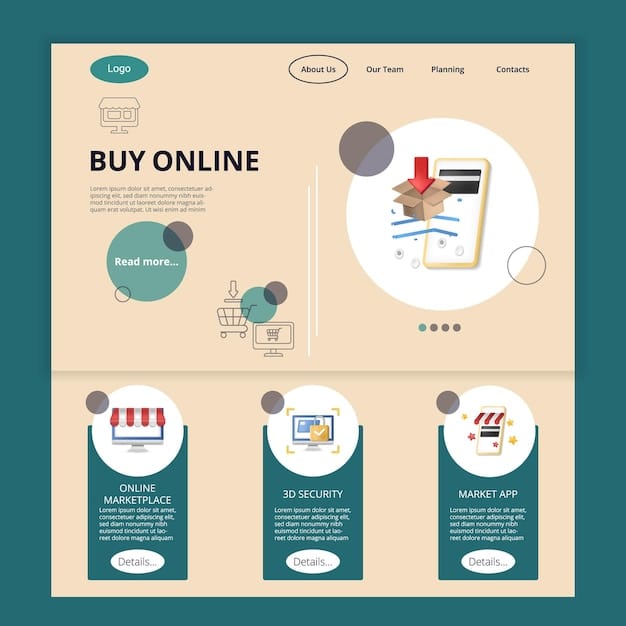E-commerce SEO in 2025: Top Ranking Factors You Need to Know

E-commerce SEO in 2025: Top 5 Ranking Factors You Can’t Ignore (Based on Recent Algorithm Updates) emphasizes the vital components for online store optimization, focusing on user experience, mobile-first indexing, visual search, local SEO, and personalized content. These strategies are crucial for enhanced visibility and conversion in the competitive e-commerce landscape.
The e-commerce landscape is ever-evolving, and staying ahead means understanding the latest SEO trends. As we approach 2025, algorithm updates are reshaping how online stores rank in search results. Ignoring these changes could mean losing valuable traffic and revenue.
That’s why it’s crucial to focus on the E-commerce SEO in 2025: Top 5 Ranking Factors You Can’t Ignore (Based on Recent Algorithm Updates). What are these factors, and how can you implement them effectively? Let’s dive in and discover the strategies that will keep your e-commerce business thriving.
Understanding E-commerce SEO in 2025
E-commerce SEO is about more than just keywords. It involves optimizing every aspect of your online store to improve its visibility in search engine results pages (SERPs). In 2025, several factors will dominate the SEO landscape, requiring e-commerce businesses to adapt and innovate.
The Evolution of Search Algorithms
Search engine algorithms are constantly evolving to provide users with the most relevant and high-quality results. In recent years, there’s been a significant shift towards:
- User Experience (UX): Websites that offer a seamless and enjoyable browsing experience are favored.
- Mobile-First Indexing: With the majority of online shopping happening on mobile devices, mobile optimization is paramount.
- Semantic Search: Understanding the context and intent behind search queries is crucial.
Why Focus on These Ranking Factors?
Focusing on the E-commerce SEO in 2025: Top 5 Ranking Factors You Can’t Ignore (Based on Recent Algorithm Updates) ensures that your store is not only visible but also provides a valuable experience to potential customers. This, in turn, leads to higher rankings, more traffic, and increased sales.

In conclusion, understanding the evolution of search algorithms and prioritizing key ranking factors is essential for any e-commerce business looking to thrive in 2025. Adapting to these changes will ensure visibility, improve user experience, and drive sales.
Top 5 Ranking Factors for E-commerce in 2025
Let’s delve into the top 5 ranking factors that will significantly impact your e-commerce SEO strategy in 2025. These factors are based on the most recent algorithm updates and are crucial for staying competitive.
1. Exceptional User Experience (UX)
User experience is king. Search engines prioritize websites that offer a smooth, intuitive, and engaging experience. Factors to consider include:
- Site Speed: Optimize your site for faster loading times.
- Mobile-Friendliness: Ensure your site is fully responsive and works seamlessly on all devices.
- Easy Navigation: Make it easy for users to find what they’re looking for.
2. Mobile-First Indexing
Given the increasing use of mobile devices for online shopping, search engines now primarily use the mobile version of your website for indexing and ranking. Ensure your mobile site is:
- Fully Optimized: All content and features should be available on mobile.
- Fast Loading: Mobile users expect instant results.
- User-Friendly: Easy to navigate and use on smaller screens.
3. Visual Search Optimization
Visual search is on the rise, allowing users to search for products using images. To optimize for visual search:
- Use High-Quality Images: Clear and professional product photos are essential.
- Add Alt Text: Describe your images accurately using relevant keywords.
- Schema Markup: Implement schema markup to help search engines understand your images.
4. Local SEO for E-commerce
Even if you’re an online-only store, local SEO can still play a significant role. Focus on:
- Google My Business: Optimize your listing with accurate information.
- Local Keywords: Use location-specific keywords in your content.
- Customer Reviews: Encourage customers to leave reviews on Google and other platforms.
5. Personalized Content
Personalization enhances user experience and engagement. Techniques include:
- Dynamic Content: Display content tailored to individual users based on their browsing history and preferences.
- Personalized Recommendations: Suggest products that users are likely to be interested in.
- Customized Email Marketing: Send targeted emails based on user behavior.
In summary, focusing on these 5 key factors – UX, mobile-first indexing, visual search, local SEO, and personalized content – is crucial for E-commerce SEO in 2025: Top 5 Ranking Factors You Can’t Ignore (Based on Recent Algorithm Updates). Each element contributes to a better user experience and improved search engine rankings.
How Algorithm Updates Impact E-commerce SEO
Algorithm updates are the driving force behind SEO changes. Understanding how these updates affect e-commerce is crucial for maintaining and improving your search engine rankings. Ignoring the E-commerce SEO in 2025: Top 5 Ranking Factors You Can’t Ignore (Based on Recent Algorithm Updates) could lead to decreased visibility and lost revenue.
Staying Updated with Algorithm Changes
Search engine algorithms, particularly those of Google, are continuously updated. These updates aim to improve the quality and relevance of search results. To stay informed:
- Follow Industry Blogs: Stay updated with the latest news and insights from SEO experts.
- Monitor Google Updates: Keep an eye on official announcements from Google.
- Use SEO Tools: Utilize tools that track algorithm changes and their impact.
Adapting Your Strategy Based on Updates
When algorithm updates are released, it’s crucial to adapt your e-commerce SEO strategy accordingly. This may involve:
- Revising Keyword Strategy: Identify new and emerging keywords.
- Optimizing Content: Ensure your content is relevant, high-quality, and user-friendly.
- Improving Site Structure: Make sure your site is easy to navigate and crawl.
Examples of Recent Algorithm Updates
Recent algorithm updates have emphasized:
- Core Web Vitals: Focusing on site speed, interactivity, and visual stability.
- E-A-T (Expertise, Authoritativeness, Trustworthiness): Highlighting the importance of credible and trustworthy content.
- Mobile Experience: Prioritizing mobile-friendly websites.
By staying informed about algorithm changes and adapting your strategy accordingly, you can ensure that your e-commerce store remains competitive in search engine results. Ignoring the impact of these updates can lead to significant drops in visibility and traffic.
Optimizing User Experience for Higher Rankings
In the realm of E-commerce SEO in 2025: Top 5 Ranking Factors You Can’t Ignore (Based on Recent Algorithm Updates), optimizing user experience (UX) is paramount. Search engines prioritize websites that not only provide relevant content but also offer a seamless and enjoyable browsing experience. Let’s explore how you can enhance UX to boost your rankings.
Key Elements of E-commerce UX
Several key elements contribute to a positive e-commerce UX:
- Intuitive Navigation: Ensure your site is easy to navigate, with clear categories and search functionality.
- Fast Loading Times: Optimize your site for speed to prevent users from abandoning their shopping experience.
- Mobile Responsiveness: Make sure your site is fully responsive and functions flawlessly on all devices.
Strategies to Improve UX
To improve your e-commerce UX, consider the following strategies:
Simplify Navigation
Ensure that users can easily find what they’re looking for with clear and intuitive navigation menus.
Optimize Site Speed
Reduce loading times by optimizing images, leveraging browser caching, and using a content delivery network (CDN).
Enhance Mobile Experience
Make sure your site is fully responsive and provides a seamless experience on mobile devices.

Optimizing user experience is not just about aesthetics; it’s about providing a valuable and enjoyable experience for your customers. By focusing on intuitive navigation, fast loading times, and mobile responsiveness, you can significantly improve your e-commerce SEO and drive more sales.
Leveraging Visual Search and Local SEO
Two increasingly important aspects of the E-commerce SEO in 2025: Top 5 Ranking Factors You Can’t Ignore (Based on Recent Algorithm Updates) are visual search and local SEO. These strategies cater to the evolving ways consumers search for and discover products online. By leveraging these tactics, e-commerce businesses can significantly enhance their visibility and attract more customers.
Optimizing for Visual Search
Visual search allows users to search for products using images, offering a more intuitive and efficient way to find what they’re looking for. To optimize for visual search:
Use High-Quality Images
Ensure your product images are clear, well-lit, and professionally shot.
Add Descriptive Alt Text
Accurately describe your images using relevant keywords. This helps search engines understand the content of your images.
Implement Schema Markup
Use schema markup to provide search engines with additional information about your products and images.
The Importance of Local SEO for E-commerce
Even if you operate exclusively online, local SEO can still benefit your e-commerce business. To improve your local SEO:
Optimize Google My Business Listing
Ensure your Google My Business listing is complete and accurate, with up-to-date information about your business.
Use Local Keywords
Incorporate location-specific keywords into your website content, product descriptions, and blog posts.
Encourage Customer Reviews
Encourage customers to leave reviews on Google and other review platforms. Positive reviews can significantly boost your local SEO.
| Key Element 🔑 | Brief Description |
|---|---|
| 🔍 Visual Search | Use high-quality images and descriptive alt text. |
| 📍 Local SEO | Optimize your Google My Business profile. |
| ⭐ Reviews | Encourage customers to leave positive reviews. |
| 📱 Mobile-Friendly | Ensure seamless experience on mobile. |
Frequently Asked Questions (FAQs)
The top 5 ranking factors include user experience (UX), mobile-first indexing, visual search optimization, local SEO, and personalized content. Focusing on these elements will enhance visibility and drive sales.
Improve UX by ensuring intuitive navigation, optimizing site speed, and providing a seamless mobile experience. These factors will keep users engaged and reduce bounce rates.
With most online shopping happening on mobile, search engines now primarily use the mobile version of your website for indexing and ranking. Optimizing your mobile site is crucial for visibility.
Visual search allows users to search using images. Optimize by using high-quality images, adding descriptive alt text, and implementing schema markup to help search engines understand your visuals.
Local SEO helps you target customers in specific geographic areas, even if you’re online-only. Optimize your Google My Business listing and use location-specific keywords to attract local traffic for E-commerce SEO in 2025: Top 5 Ranking Factors You Can’t Ignore (Based on Recent Algorithm Updates).
Conclusion
In conclusion, adapting to the changing landscape of e-commerce SEO is crucial for success in 2025. By prioritizing user experience, mobile optimization, visual search, local SEO, and personalized content, businesses can improve their search engine rankings and drive more sales.
Staying informed and implementing these strategies will ensure that your e-commerce store remains competitive and visible in the ever-evolving digital marketplace. Remember to focus on the E-commerce SEO in 2025: Top 5 Ranking Factors You Can’t Ignore (Based on Recent Algorithm Updates).





